The number of smartphone users worldwide is projected to surpass 6.64 billion in 2021. And every business is in a rush to grab a pie of the resulting opportunities. As a result, the app market is in a frenzy. We’ve 6.8Mn+ apps today across different app stores with businesses launching 117k+ new mobile apps every month on Apple and Google Play Stores alone. But are all apps successful? Obviously not. Read this insight to discover 5 QA best practices to boost the success chances of your app.
Why on-spot mobile app QA practices can make or break your business?
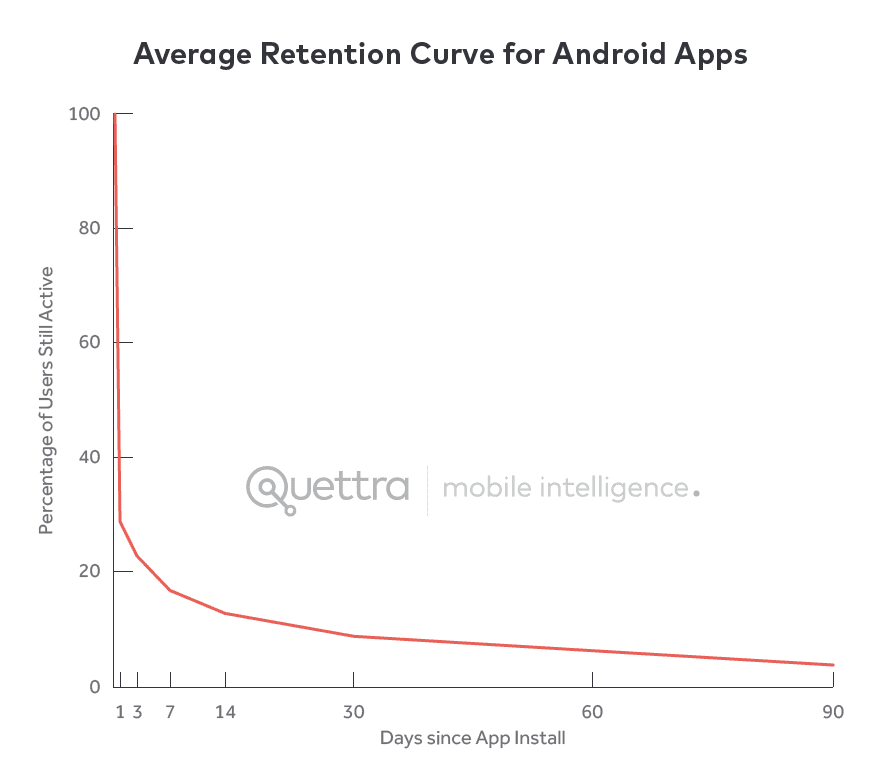
Businesses invest enormous amounts of time, effort, and money in designing, developing, and launching a mobile app. And it’s heartwrenching when users uninstall the app. In fact, an average mobile app tends to lose somewhere around 77% of Daily Active Users (DAUs) just within three days of its installation.
If you’re an industry insider, you would be aware of these problems and would be wondering about potential reasons behind this high user churn rate.
Well, there could be multiple trigger points. But from our experience of building 300+ web and mobile app solutions, we kind of know all the major variables that make or break an app. One of the major app abandoning triggers is bugs and glitches experienced by users.

88% of app users say that they uninstall apps if they experience glitches.
That’s too big a number to ignore. And what’s the solution? While bugs and glitches will always be there as app development technologies evolve, you can definitely minimize the number of bugs and subsequently, the app abandonment rate. How? By adhering to the best development practices and implementing a robust QA pipeline.
While Zoom’s security glitches were one of the most discussed tech topics of 2021, here are some others to emphasize the importance of having a proper quality assurance team.
- Ola, the largest cab aggregator faced major vulnerabilities in the system. The technical glitch allowed unlimited free rides at the expense of Ola or at the expense of genuine users. The bugs were fixed at the cost of the brand’s reputation which was momentarily hit. Identifying and fixing the defect before the app was released to the public would have saved Ola from this embarrassment.
- In May 2015, Airbus issued an alert for urgently checking its A400M aircraft when a report detected a software bug that had caused a fatal crash earlier in Spain. Prior to this alert, a test flight in Seville had caused the death of four air force crew members and two were left injured.
- In January 2012, 50 inches, 3D TVs worth £1,099 were priced a mere £199 on the Marks and Spencer website. The online petition called ‘Marks & Spencer supply the TVs that we paid for’ compelled M&S to sell the Plasma TV sets at the lowered price to honor the orders.
For your app to grow, the user acquisition rate should be higher than the user churn rate. And with over 6.8 million apps in the market, users are spoilt for choice. They always have an alternative for your app. It is extremely important to meet the users’ expectations and earn their loyalty. You cannot afford to carelessly release bugs. You should be on top of your QA game if you wish to survive and thrive in this cut-throat globalized economy. Let’s now dive deeper into
What exactly is QA in app development?
Quality Assurance (QA) is a set of standardized practices and processes to ensure that the developed app meets the desired quality standards in terms of usability, functionality, and security. It’s implemented throughout the software development lifecycle i.e., across requirement analysis, design, development, testing, and maintenance stages of mobile application development.
QA your best leg forward to ensure that the shipped app is flawless and free from bugs, glitches, and security vulnerabilities.
QA plays a pivotal role in
- Prevention, detection, and fixing of the bug
“A stitch in time saves nine” is an age-old adage. A bug that is identified in the early stages of development is easier to be fixed and less costly than when it flows into the later stages like the implementation phase or the testing phase of the development cycle. For example, if two or more functions are interdependent then a bug in one might expose a flaw in the other. In large projects, this could sprout a chain of bugs, and fixing them would take 100s of developer hours, and the company’s resources.
- Charm app users with flawless UX
According to psychologists, the first impression is made within 5 seconds of meeting someone. Not just that, first impressions are impactful and difficult to change too. An app that works without any glitches and with the best UX experience is most likely to give the best first impression to the user. And that translates into higher user retention rates.
- Checking for robustness and reliability of the app
The mobile app developed should not break under unfavorable environments and should function as expected. That means, your app should be responsive, and functional irrespective of the screen resolution, operating system, device type, server load, network speed, or time-zone of the user.
So, is QA the same as testing?
Let’s figure that out.
QA vs QC vs Testing?
QA is process-oriented. QC is product-oriented. Testing is execution-oriented.
What does that mean?
We will get to that in a moment. First, let’s get clear about the end goal of these three.
The purpose of QA, QC, and Testing is the same. These ensure that app UI/UX, functionality, security-related flaws are detected and fixed at an early stage while developing mobile apps and deliver a seamless experience to the end-users.
When we say that QA is process-oriented, it means QA is more about defining processes, selecting and implementing tools, training talent for app quality controlling, app testing, and also iteratively auditing existing QA processes. In short, QA ensures the effectiveness of QC and eventually Testing.
Quality control aka QC is product-oriented. While QA is proactive i.e., focuses on preventing the defects, QC is reactive i.e., focuses on identifying defects and fixing them. QC involves technical reviews, app testing, and code inspections. On a high level, QC is a set of activities to ascertain that the end result is in conformance with the requirements.
Testing is a subset of QC. It is the manual/automated process of executing test cases to identify bugs and issues so that developers can fix them.
Evolution of QA
Earlier, the Waterfall model was predominantly followed for developing projects. QA & testing used to come into the picture after the product was completely developed. It was comparatively slow and prone to errors. Recently, the QA has shifted towards the left in the development cycle. Quality techniques are implemented from the time of conception and run through the maintenance phase of the project. With DevOps and agile, automated app testing has become quite popular today.
DevOps model is basically- “everyone is responsible for the quality of the final product”. The boundaries between the roles of QA and development are blurred in a DevOps world. Today, many developers themselves write and run unit tests on their code before delivering it to the testing team.
We hope that now you have clarity about QA and the associated terminologies. Let’s get to the best practices now.
What are the 5 Best QA Practices to build successful Apps?
- The sooner you integrate QA into the development process, the better it is
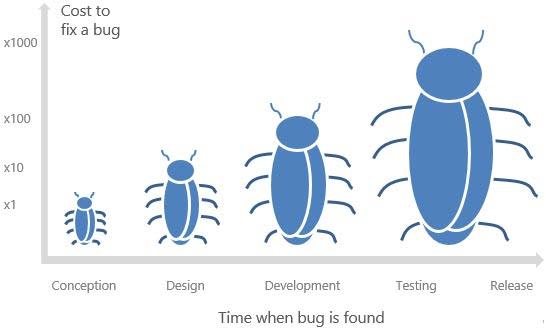
QA is no longer a one-time activity. Now, in an agile software development world, it’s an ongoing, iterative process that starts in the requirement phase itself and continues through the maintenance phase of the app.
Rectifying an ambiguous requirement that is detected at the conception stage would cost less than fixing the same problem when it creeps up as a bug in the later stages of app development.
We also recommend Test-Driven Development (TDD) & Behavior Driven Development (BDD) integrated with development. TDD pushes us to script test scenarios, to make the code fail and then the developer writes the code, to make all conditions pass. TDD can push programmers to not just cover functional scenarios (happy, alternate, exception flows) but also ensure security compliances, speed optimizations, responsiveness optimizations are done – when the module is being developed.
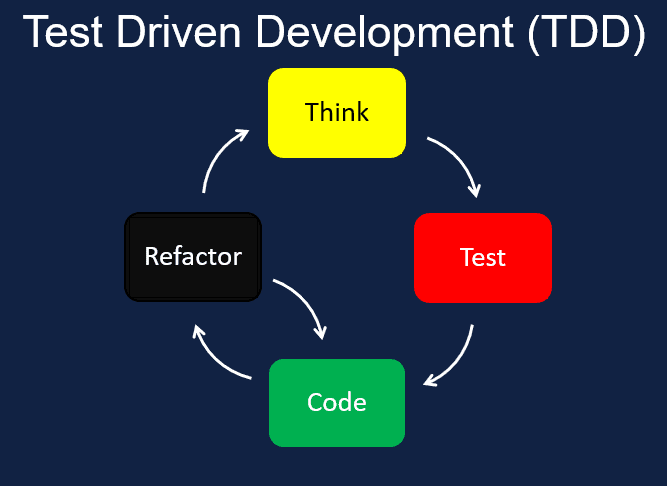
Behavior Driven Development (BDD) – makes a BA collaborate with QA, to come up with “Acceptance Criteria” that needs to be met, in order to call a module complete.
In short, TDD strengthens collaboration between Developers & QA. BDD strengthens collaboration between Business Analysts & QA. Together TDD & BDD ensures holistic test strategy, planning & execution throughout the project, starting from Day 0.
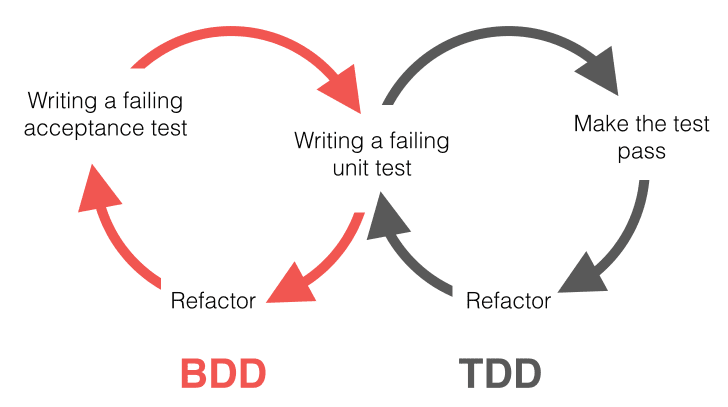
Couple of key challenges our QA team faced (mostly with manual testing):
- Insufficient QA time to respond to frequent builds, lesser time to test builds, look up issues from past versions & prioritize fixes
- Code reviews & one level unit testing can happen at the code level – to ensure basic exceptions for stability are taken care
To solve the above problem, we suggested implementing TDD practice, where:
- QA member takes a use case & scripts the logical conditions required to make Dev’s code pass. QA’s script will initially fail, as no code is written yet. Devs will start writing only minimal code to make the criteria pass. QA can add criteria – for functionality success, performance, security, responsiveness, etc.
- With TDD QAs will be working in parallel to BA & Dev UI team – ensure scripts are written before coding for the particular use-case starts.
- Above TDD scripts would be written once, can be run any number of times – during build releases for testing multiple builds. Regression testing pain is eliminated. Testcase documentation can be a direct export of TDD scripts, instead of manual BDD scenarios written in natural language.
What can work well for teams in agile environments:
- Instead of saying – “QA needn’t come in week 1 of the project” we can start saying – “QA can pair up with BAs to expand success criteria”
- Instead of saying – “Unit testing is Dev’s job, not QA’s” we can start saying – “TDD makes Devs & QAs life simpler”
- Instead of saying – “Builds coming last minute with issues” we can start saying – “Doesn’t matter how many builds come anytime – in a push of a button, I can check them the next morning”
- Instead of saying – “QA tests code which is written by someone” we can start saying – “QA scripts logic to help how the code is written”
- Instead of saying – “QA is not able to handle 2 projects at a time” we can start saying – “QA can better split time as part-time scripters”
Codewave is currently using testproject.io for automation of test execution, integrated with CI/CD for automated continuous deployments.
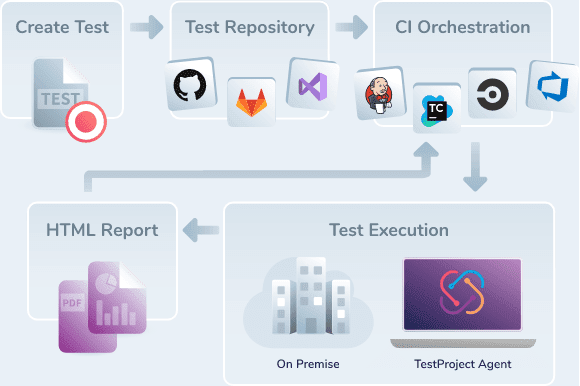
- Effective QA teams see beta testers as their extended team
Beta testing is the key to a successful mobile app. While alpha testing is done by the in-house testers in a lab environment, beta testing is performed after alpha testing i.e., by the real users in the real environment.
Often, most companies don’t know there is a problem with the app until real users encounter them. It is very rare for even a successful app to be launched without minor bugs or defects. As per a study, 44% of app bugs or defects are first noticed by users. And maybe that’s why the Microsofts and Facebooks of the world have bug-bounty programs in place.
A wisely chosen group of beta testers would include users from your target market’s geographic locations who use your app under varying network conditions on different platforms. This could help identify bugs that would otherwise go unnoticed. At the same time, it is equally important to create a community of beta users for easy networking and respect the feedback you receive.
- Role clarity- every project must have a dedicated QA specialist
It is always worth remembering that the developers are not testers, QA specialists neither. It’s hard for developers to find flaws in their own work. While developers work thinking about how to make the app, testers have to think about how and when the app would break. The approach for each of them is different.
Real-time app testing is the key to faster time to market. With so many screen resolutions, mobile operating systems, and their versions available out there, a dedicated proactive QA team will be a great decision.
A ‘small’ mistake that could be easily overlooked can prove to be direful. We all know how a missing zero at the end of an integer can lead to a catastrophe.
So, detailed checklists, proper documentation, rigorous review, elaborate testing, appropriate tools, and relevant training would make the QA process assuring. The app thus developed would be sturdy and trustworthy.
- Collaboration, communication, and holistic manual + automated testing
Manual testing is not dead, and we don’t feel it will ever be. But automation has clearly won the QA world as it saves testers time, improves the app’s time to market, and boosts productivity too.
In the automated QA world, collaboration tools and effective communication skills are the most sought-after things.
The QA, development, and QC responsibilities have breached responsibility boundaries and need a holistic effort from each of the stakeholders involved in the app development process. Collaboration tools like Jira, testing tools like Selenium and Appium, and intercommunication between QA, QC, Developers, and DevOps teams can spell magic.
A comparison matrix of the available tools and how they fare on the different criteria will help us choose the right tool. Among the various tools available, choosing the right tool is time and effort consuming but in the long run, it is worth the investment.
The comparison matrix of some common tools is as follows –
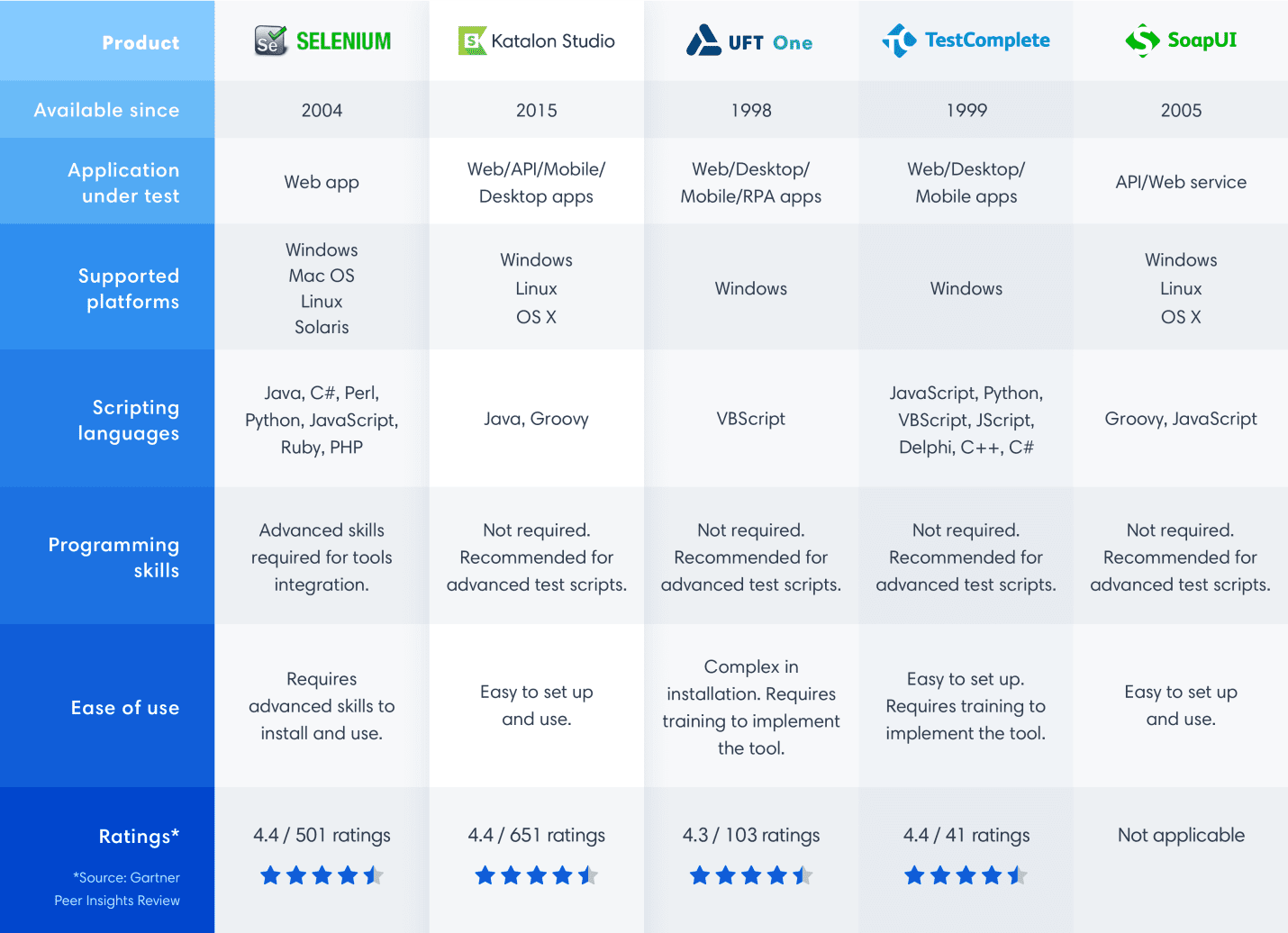
The appropriate automation tool for testing the mobile is identified based on the following attributes:
- License cost
- Scripting language
- Scripting time
- Skill available and the learning time
- Support system available: organizational help, user and professional help, community help, etc.
- Script maintenance and reusability
- Platform supported(Device and OS compatibility)
UX is one of the deciding factors that mark or mar the app. When it comes to UX testing of the app, automation testing cannot replace manual testing. Manual testing also aids in random testing and exploratory testing which is not possible with automated testing.
The amalgamation of the two types of testing in the right amount is therefore one of the app success secrets. You got to invest in fixing every loophole that might break your app.
- Cloud Testing
Cloud testing is the latest trend in the QC world, and QA teams should not overlook this trend. Cloud testing enables you to test your applications in the cloud without having to invest heavily in the testing infrastructure. So, you can test your app frugally on a set of target devices without actually spending on physical devices. Cloud testing service providers empower you to test your apps using browser applications. You can test your app in the cloud on various devices, different operating systems, versions, network connectors. Cloud testing platforms help you configure and emulate mobile devices using APIs and web clients.
Cloud testing has various advantages like
- Reduced infrastructure and maintenance cost
- Scalability
- Flexibility & collaboration- Test from anywhere, anytime
- Augments the agile paradigm
Bonus tip 1: Audience analysis
Audience analysis is perhaps underrated and does not get the consideration it actually deserves. The QA should design test cases based on the target audience of the mobile app. Extensive research on the audiences’ demography, gender, culture, and socio-economic conditions would help in narrowing the scope of the test cases accordingly.
With thousands of devices, and OS variants that change before even you know it, it is important to niche down the audience for the app and focus the testing parameters based on the audience analysis.
Bonus tip 2: Essential foresight
‘Change is the only constant’ is as clichéd as it is true.
It is of importance to know about the next versions of the various platform elements the app is dependent on and streamline QA with sufficient skills, processes, systems, and testing ideas so that you don’t react to the change but respond, and respond with utmost preparedness.
Wrapping up
QA is crucial for mobile app development. Complying with these 5 QA best practices would prepare a solid ground for your app to attain skyrocketing growth.
At Codewave, we adhere to all the aforementioned practices and do our best to give more strength to your entrepreneurial wings. We embed QA, design-thinking, agility, and security in all stages of the app development lifecycle to ensure that your users get more than what they want from the app. We put our best efforts to make your idea a success. And thankfully, the hard work of our developers and consultants has brought a smile to the faces of our 300+ partners since 2013. Do explore our works and case studies. Contact our design & dev consultants for developing design-thinking-led innovative digital solutions.
Frequently Asked Questions(FAQs)
What are the best practices for QA?
QA processes should be integrated into a project from the genesis to its final delivery and beyond. Also, QA teams can extend with beta testers, cut the infrastructure requirements with cloud testing, and speed up the process with automated tests.
How can QA practices be improved?
Ensuring that every project has a QA specialist, and adhering to the best QA practices in-line with what has been shared in this insight can significantly help improve the QA process.
Why ensuring the quality of the developed app is important before its release?
An average mobile app tends to lose somewhere around 77% of Daily Active Users (DAUs) just within three days of its installation. A majority of this attrition is because of app crashes and glitches. And thus, QA is critical for an app’s success.








